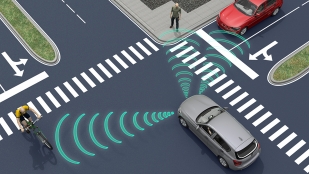Last of its Kind: Bridge Has New Home & Purpose (VIDEO)
According to the 2021 Report Card for America’s Infrastructure published by the American Society of Civil Engineers (ASCE), 42% of our nation’s 617,000 bridges are over 50 years old and nearly 231,000 of them across the country are in need of repair and preservation work. Failing and structurally deficient bridges are another sad casualty in the story of America’s severely degrading infrastructure, and a funding target in President Biden’s proposed $2.25T American Jobs Plan Act.
If the Act passes this year, local communities will receive funding to repair and restore their bridges—like the Michigan Department of Transportation recently did with the rehabilitation and relocation of its historic M-86 Camelback Pony Truss Bridge in St. Joseph County.
OHM Advisors was part of the collaborative team that worked on this complex, layered project that recently won the 2021 Governor’s Award for Historic Preservation from the Michigan Economic Development Corporation—its second award in the last two years! We sat down with Senior Project Manager Al Halbeisen to chat about the nuances of this project, the bridge’s historic significance, and its meaning to the members of its new community.
Q&A with Al Halbeisen
Q: Congratulations on the second award for this meaningful community project! You’re an expert on historic bridge preservation, having worked on a variety of bridge restoration projects, starting with the Douglas A. MacArthur Bridge in the early 1980s. How does this project compare in significance with other preservation projects you’ve helped design?
A: In 2023, the M-86 bridge will have its one hundredth birthday! Of course, most preservation projects are about working on older structures, but this is a big milestone for an 84-foot-span pony truss bridge—especially one that has now moved to its third home over its lifetime. It’s different because it was the last of its kind on a trunkline in Michigan, but it was deteriorating and no longer meeting the needs of the state trunkline roadway system at its location in St. Joseph County. MDOT [Michigan Department of Transportation] had expanded the width of the roadway since the bridge was moved there from Detroit in 1938, and the bridge’s shoulder width couldn’t accommodate that growth. It had not only become structurally deficient due to its age, but functionally obsolete as well. So, MDOT determined that the historic bridge had to be replaced, and it began considering relocating it to another site to be used on trails or low volume roads.
The relocation idea was very similar to a project that I worked on in the mid-1990s with Kent County Road Commission and the City of Portland—a unique project for that time which involved restoration and relocation of a two-lane pony truss bridge from Wayne County to Kent County, where it replaced a one-lane pony truss that was moved to the City of Portland for a trail system. Although SHPO’s first reaction at the time did not favor relocation of historic bridges, we were able to persuade it of the benefits, and their decision approving it led the way for many other relocation projects like the M-86. Reusing a historic bridge that no longer meets the needs of system in its current location is such a great demonstration of unconventional thinking to preserve an important piece of history.
Q: What challenges did the project team face due to the bridge’s advanced age?
A: Historic preservation projects always have challenges due to the age of the structure, but we had a great, collaborative team that was excited about the project and solving those challenges. The bridge had structurally deteriorated to well below regulatory standards and had to be rehabilitated to MDOT design standards while satisfying SHPO criteria (which required the use of over 1,400 steel rivets to reassemble the bridge sections as the original construction used). The major structural design effort for this project was determining the portions of the existing bridge that could be salvaged, which pieces needed to be removed, and how to dismantle the bridge to accomplish those efforts in the most efficient manner. In a truss bridge there are many interconnecting parts, and the connection sequence is important to understand.
The contractor chose to ship the steel portions of the bridge which were capable of being salvaged to an enclosed site in Ecorse, Michigan where a restoration specialist could work on the parts and where the steel was sandblast cleaned and coated with a three-coat paint system. Some portions of the bridge were too deteriorated to salvage and had to be replaced with new steel, and reinstallation of those replacements had to take place prior to their paint system coating. It was like assembling the pieces of a puzzle.
There were some unforeseen project delays due to artesian water pressure problems at the new site when the contractor started to build the new bridge foundations, which required redesign of the foundation cofferdam enclosures. The restored steel structure had to be painted in its final vibrant blue color and stored off-site until the foundations could be completed. Instead of wrapping up in 2017 as planned, the project opening was delayed until September 2018.
Q: There’s a lot of talk about considering and building in sustainability when communities prepare to improve, repair or replace their infrastructure assets. How was that considered in this project?
A: Usually we hear sustainability discussed in terms of the use of new or alternative materials to construct a project. But in this case, the entire concept for the project was an exercise in commitment to sustainability—one that’s been ongoing since the bridge was built in Detroit in 1923. The bridge is nearly a century old and living in its third location! That’s a testament to the physical sustainability of the original structure—with maintenance efforts along the way—and to the creative thinking of transportation officials to sustain its use as a long-term infrastructure asset to continue to serve the public while maintaining its historic character.
Q: In your experience, what’s the toughest hurdle to overcome in the historic preservation projects you’ve worked on in your career? We’re going to go out on a limb here and guess that your answer might be “funding.”
A: Your guess wouldn’t be wrong, since lack of infrastructure funding is what has led the country to the poor state of its historical and other bridges. However, historic preservation projects are often funded—at least in part—by grants from public or private historic preservation and rehabilitation programs and through federal TAP (Transportation Alternatives Program) funding that can be very helpful in getting a project moving, as it did with this one. Since the cost of restoration can be higher than a simple replacement, the toughest hurdle in these projects is to make sure the restored bridge will fit the needs of the site, whether that be the existing location or a new location.
Q: The project has earned two significant awards so far (the first being the 2020 APWA Michigan Project of the Year in the Historic Preservation $1-5M category), and we know that must mean a lot to you and the rest of the project team. What do you think the bridge means to the people of its newest home community?
A: Cass County residents and stakeholders were vocally enthusiastic with their support for the bridge relocation since the public meeting hosted by MDOT very early on in the project. People usually want to retain important pieces of history—especially ones that can be rehabilitated and then serve to enhance the overall community aesthetic.
I’m not a resident of Cass County, but I hope that the bridge relocation is as successful as the project I worked on with the City of Portland—which included restoration of a key vehicular crossing of the Grand River immediately connected to the business district and led to the city incorporating the bridge’s likeness on its brand logo—and the Kent County bridge relocation that helped expand that city’s trail system. I’m thrilled that the Cass County community hosted a ribbon-cutting ceremony when the M-86 bridge reopened to traffic over the Dowagiac River in 2018 and seemed very excited about the pony truss bridge as a new community landmark. Both local motorists and river recreational users will be able to enjoy it long into its second century.








